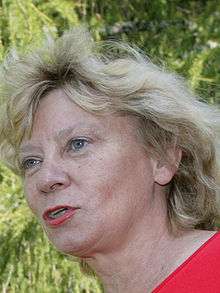Swiss federal election, 2003
 | |||||||||||||||||||||||||||||||||||||||||||||||||||||||||||||||||||||||||||||||||||||||||||||||||||||||||||||||||||||||||||||||||||||||||||
| |||||||||||||||||||||||||||||||||||||||||||||||||||||||||||||||||||||||||||||||||||||||||||||||||||||||||||||||||||||||||||||||||||||||||||
| |||||||||||||||||||||||||||||||||||||||||||||||||||||||||||||||||||||||||||||||||||||||||||||||||||||||||||||||||||||||||||||||||||||||||||
.svg.png) |
| This article is part of a series on the politics and government of Switzerland |
|
|
Politics portal |
Federal elections were held in Switzerland on 19 October 2003.[1] Although in Switzerland's peculiar political system, in which all four major parties form a coalition, it is very difficult to achieve a change of government, this election produced an upset with the strong showing of the right-wing, anti-European Union and anti-immigration Swiss People's Party. The left-wing parties, the Social Democrats and the Greens, also improved their positions. The losers were the parties of the centre and centre-right, the Christian Democratic People's Party and the Free Democratic Party.
In the aftermath of the elections Ruth Metzler-Arnold, one of the two Christian Democrats in the Federal Council was replaced by Christoph Blocher, the most influential politician in the Swiss People's Party.
Electoral system
Switzerland has a bicameral legislature, the Federal Assembly (Assemblée Fédérale / Bundesversammlung / Asamblea Federale / Assemblea Federala).
- The National Council (Conseil National / Nationalrat / Consiglio Nazionale / Cussegl Naziunal) has 200 members, elected for four-year terms by proportional representation in multi-member constituencies corresponding to the 26 Swiss cantons and half-cantons.
- The Council of States (Conseil des Etats / Ständerat / Consiglio degli Stati / Cussegl dals Stadis) has 46 members elected for four-year terms from multi-member and single-member constituencies.
These elections were to the National Council and for most of the members of the Council of States.
All parties in Switzerland have different names in French, German and Italian, and conduct separate campaigns in the different language areas.
Results
National Council
| Party | Votes | % | Seats | +/– |
|---|---|---|---|---|
| Swiss People's Party | 560,750 | 26.7 | 55 | +11 |
| Social Democratic Party | 490,385 | 23.3 | 52 | +1 |
| Free Democratic Party | 364,493 | 17.3 | 36 | –7 |
| Christian Democratic People's Party | 301,652 | 14.4 | 28 | –7 |
| Green Party | 156,226 | 7.4 | 13 | +5 |
| Evangelical People's Party | 47,838 | 2.3 | 3 | 0 |
| Liberal Party | 45,864 | 2.2 | 4 | –2 |
| Federal Democratic Union | 26,590 | 1.3 | 2 | +1 |
| Swiss Democrats | 20,177 | 1.0 | 1 | 0 |
| Swiss Party of Labour | 14,595 | 0.7 | 2 | 0 |
| Feminist and Green Alternative Groups | 11,153 | 0.5 | 1 | 0 |
| Solidarity | 10,562 | 0.5 | 1 | 0 |
| Christian Social Party | 7,539 | 0.4 | 1 | 0 |
| Ticino League | 7,304 | 0.3 | 1 | –1 |
| Freedom Party | 4,000 | 0.2 | 0 | 0 |
| Other parties | 32,913 | 1.6 | 0 | – |
| Invalid/blank votes | 59,880 | – | – | – |
| Total | 2,161,921 | 100 | 200 | 0 |
| Registered voters/turnout | 4,779,733 | 45.2 | – | – |
| Source: Nohlen & Stöver | ||||
Council of the States
| Party | Seats | +/– |
|---|---|---|
| Christian Democratic People's Party | 15 | 0 |
| Free Democratic Party | 14 | –3 |
| Social Democratic Party | 9 | +3 |
| Swiss People's Party | 8 | +1 |
| Total | 46 | 0 |
| Source: Nohlen & Stöver | ||
See also
References
Bibliography
- Church, Clive H. (May 2004). "The Swiss Elections of October 2003: Two Steps to System Change?". West European Politics 27 (3): 518–534. doi:10.1080/0140238042000228121.
External links
- Official voting results (German)
.jpg)

.jpg)

.jpg)